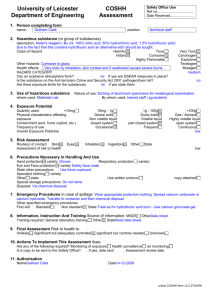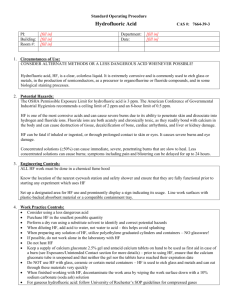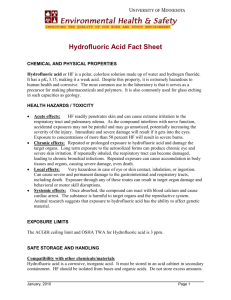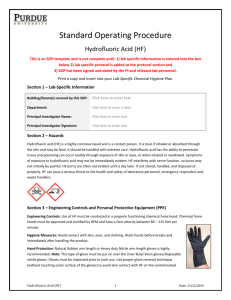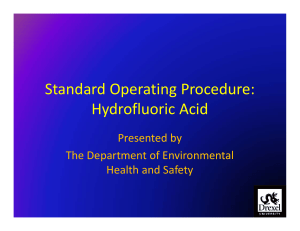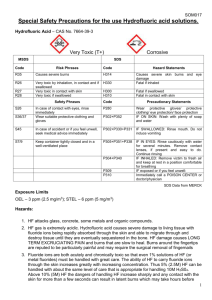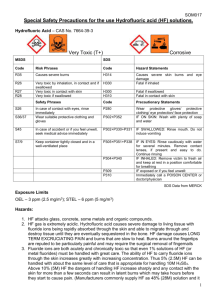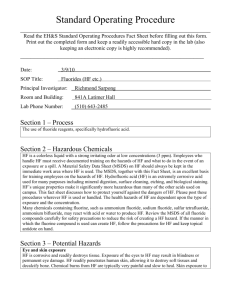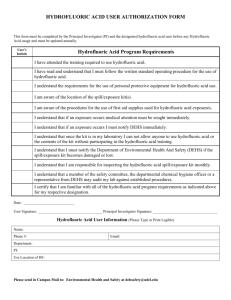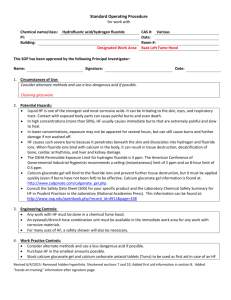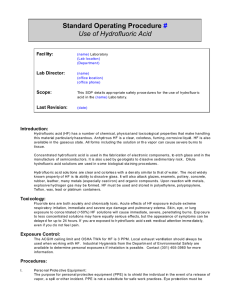Safe Use of Hydrofluoric Acid
advertisement
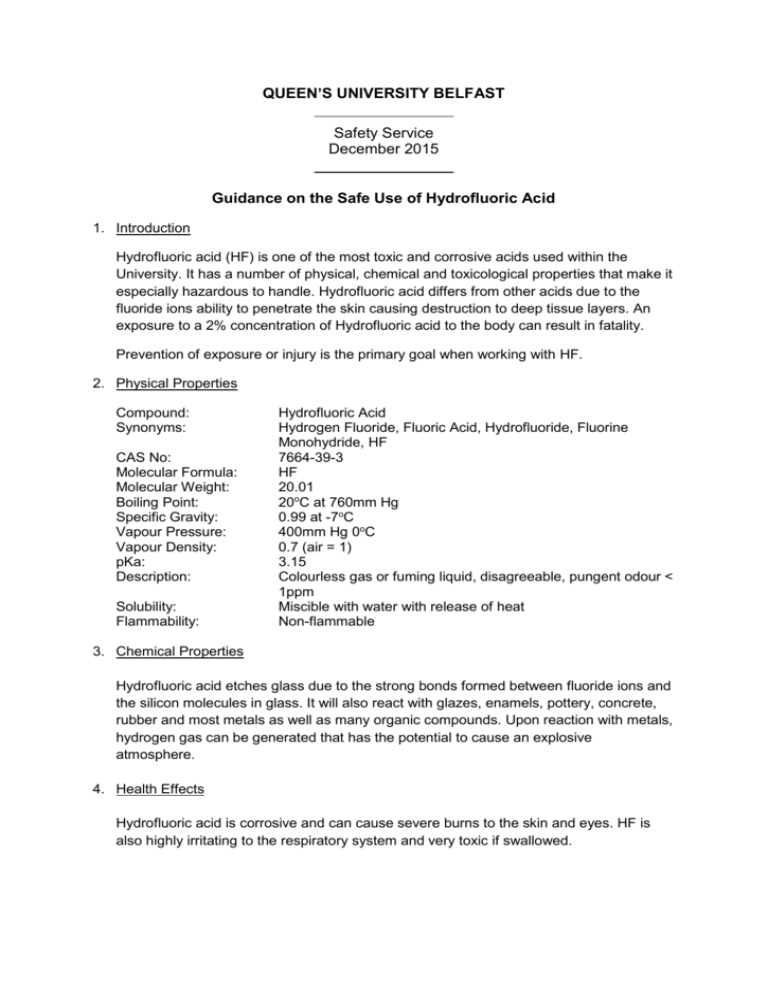
QUEEN’S UNIVERSITY BELFAST Safety Service December 2015 Guidance on the Safe Use of Hydrofluoric Acid 1. Introduction Hydrofluoric acid (HF) is one of the most toxic and corrosive acids used within the University. It has a number of physical, chemical and toxicological properties that make it especially hazardous to handle. Hydrofluoric acid differs from other acids due to the fluoride ions ability to penetrate the skin causing destruction to deep tissue layers. An exposure to a 2% concentration of Hydrofluoric acid to the body can result in fatality. Prevention of exposure or injury is the primary goal when working with HF. 2. Physical Properties Compound: Synonyms: CAS No: Molecular Formula: Molecular Weight: Boiling Point: Specific Gravity: Vapour Pressure: Vapour Density: pKa: Description: Solubility: Flammability: Hydrofluoric Acid Hydrogen Fluoride, Fluoric Acid, Hydrofluoride, Fluorine Monohydride, HF 7664-39-3 HF 20.01 20oC at 760mm Hg 0.99 at -7oC 400mm Hg 0oC 0.7 (air = 1) 3.15 Colourless gas or fuming liquid, disagreeable, pungent odour < 1ppm Miscible with water with release of heat Non-flammable 3. Chemical Properties Hydrofluoric acid etches glass due to the strong bonds formed between fluoride ions and the silicon molecules in glass. It will also react with glazes, enamels, pottery, concrete, rubber and most metals as well as many organic compounds. Upon reaction with metals, hydrogen gas can be generated that has the potential to cause an explosive atmosphere. 4. Health Effects Hydrofluoric acid is corrosive and can cause severe burns to the skin and eyes. HF is also highly irritating to the respiratory system and very toxic if swallowed. Ref: Title SS/GU/025/1 Page Issue No Issue Date 2 of 4 1 08/12/2015 Safe Use of Hydrofluoric Acid An exposure to HF may not be initially painful and symptoms may not occur immediately, sometime taking several hours, but when the acid begins to react it attacks the calcium in the bones. Under most circumstances, without treatment, exposure results in severe or even lethal damage to the heart, liver, kidneys and nervous system. In all cases, exposure requires immediate professional medical attention. 5. Precautions The Control of Substances Hazardous to Health Regulations (COSHH) apply to the use of HF. A COSHH risk assessment should be completed, firstly considering the use of safer alternatives and if there are no suitable alternatives, the assessment should detail appropriate precautions to be taken when using HF, including the use of a safe system of work. 6. Preparation and Handling Before any work can commence using HF, all users must read and fully understand the MSDS and COSHH form associated with the safe system of work to be followed. If this process has not been assessed previously, a full COSHH risk assessment must be completed. Before work commences, ensure that all lab users are aware that HF is to be used. Always ensure that appropriate warning notices are in place. Use Teflon / plastic beakers / apparatus NOT GLASS. Wear appropriate personal protective equipment i.e. Visors / goggles, gloves, lab coat, safety footwear etc. Use heavy duty acid protection gloves or double glove with the thinner nitrile gloves. Test gloves for pinholes using a method advised by the manufacturers (this might be done by filling them with water, before drying and putting them away ready for use again), discarding gloves that are not sound; Calcium Gluconate gel to be made available in the first aid kit closest to where you are carrying out the work. You must familiarise yourself with the procedure for using the antidote gel prior to work commencing. A qualified first aider should be aware when you are starting work with HF and be easily contacted. 7. Storage HF must be stored in a cool, dry area away from incompatible materials. Where possible, it should be stored within a plastic lined acid cabinet when not in use. If this is not possible, then HF should be stored in a suitable secondary container and stored within a metal cabinet. Ref: SS/GU/025/1 Title Page Issue No Issue Date 3 of 4 1 08/12/2015 Safe Use of Hydrofluoric Acid 8. First Aid Skin Contact Immediately proceed to a safety shower and flood the affected body area thoroughly with large amounts of water. Remove contaminated clothing, footwear and jewellery while rinsing. Flood the skin with plenty of water for at least 5 – 10 minutes. Apply calcium gluconate gel on and around the affected area and continuously massage it into the skin until at least 15 minutes after pain is relieved. Cover the area with a dressing soaked in the gel and lightly bandage. These procedures can be continued during transport to hospital. PVC, nitrile or neoprene gloves must be worn while touching the casualty. Send to the Accident and Emergency Department. Inform the medical personnel that the exposure involved hydrofluoric acid. Provide the doctor with all relevant information relating to the HF. Eye Contact Immediately proceed to an eye wash station and flush the eye with water for at least 20 minutes. Hold the eyelids open and away from the eye during irrigation. If the person is wearing contact lenses, the lenses should be removed if possible. If available, flush eyes with a sterile 1% calcium gluconate solution. Do not apply calcium gluconate gel to eyes. It is critical to irrigate beneath the eyelids. Send the casualty to the Accident and Emergency Department or local Eye Casualty Department. Ice water compresses may be applied to the eyes while transporting the casualty to the Accident and Emergency Departments. Inform the medical personnel that the exposure involved hydrofluoric acid. Provide the doctor with all relevant information relating to the HF. Inhalation Remove the casualty from the contaminated area and place in fresh air. If the casualty is not breathing, begin artificial respiration immediately. Avoid mouth to mouth contact by using mouth guards or shields. If suitably trained, give oxygen. Send to the Accident and Emergency Department. Inform the medical personnel that the exposure involved hydrofluoric acid. Provide the doctor with all relevant information relating to the HF. Swallowing Never attempt to induce vomiting. If the casualty is conscious, rinse out their mouth with water. Send to the Accident and Emergency Department. Inform the medical personnel that the exposure involved hydrofluoric acid. Provide the doctor with all relevant information relating to the HF. Ref: SS/GU/025/1 Title Page Issue No Issue Date 4 of 4 1 08/12/2015 Safe Use of Hydrofluoric Acid 9. Disposal All used HF must be disposed of via the University hazardous waste contractor, details of which can be obtained from the Occupational Health and Safety Service: safety@qub.ac.uk All HF waste must be placed in an appropriate, clearly labelled container. HF waste should never be mixed with any other waste.
